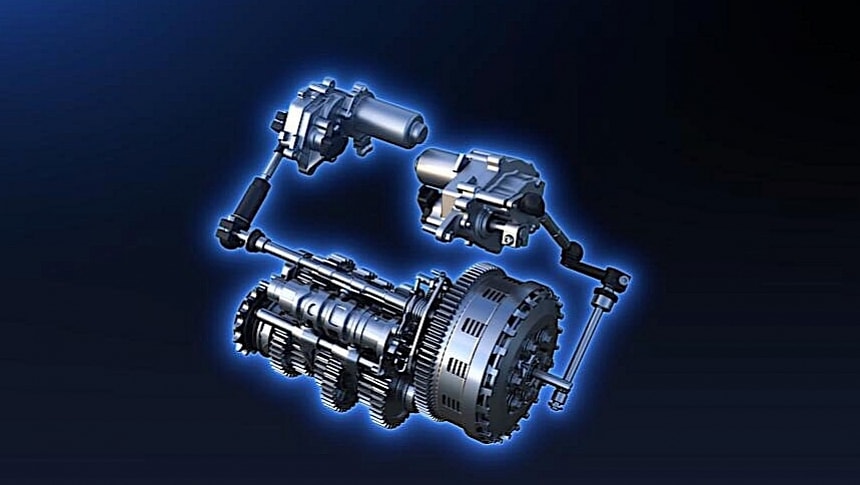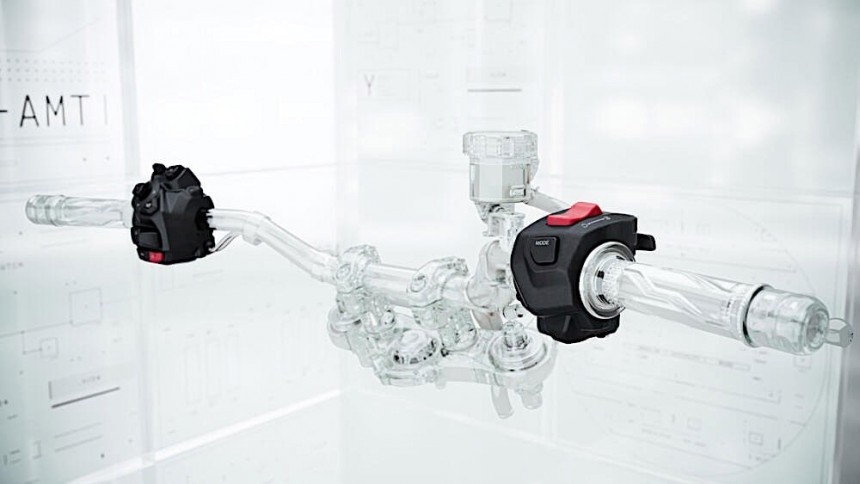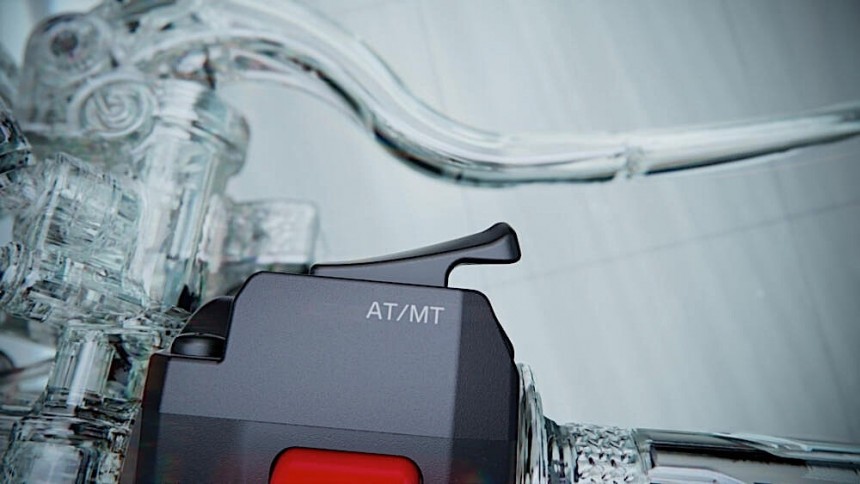Because they technically are the hearts that animate vehicles, engines, motors, and other types of drivetrains often steal the spotlight whenever a new one comes into the world. That's why talking about a new transmission, especially one meant for motorcycles, may seem a bit counterintuitive. But bear with me, because this thing is worth it.
It's Japanese bike maker Yamaha we have to thank for this, as it revealed this week something it describes as the next generation shift technology: the Y-AMT, or Yamaha Automated Manual Transmission.
Even if you're not a rider, it's easy to understand how a motorcycle operates. The engine is controlled by means of either manual or automatic transmissions, and when it comes to the former, that implies the operation of a clutch and a foot pedal.
The Y-AMT removes both these things from the equation, as it can be operated both in automated mode, but also manually, in which case a simple button will do the trick - riders will be able to select any of the two transmission modes via a thumb-operated button on the handlebar. But let's take things one at a time.
When in automated mode (AT), the transmission offers the choice of two programs. The first is the D, a series of settings that allows for softer shifting al low rpms. This allows the bike to feel smooth, and it is the setting recommended for long-distance riding on motorways and the likes, but also when in urban settings.
When more punch is required for whatever reason, the tranny can be set in D+, which makes the gears change later in the rev range. This, naturally, gives the bike's engine more kick and it is ideal for sportier, more adventurous riding.
What the Y-AMT brings new to the table is the option of switching from the AT mode to the manual one (MT). This can be done by simply engaging the see-saw shift levers located on the handlebars.
There are two of these control elements, a plus one for upshifts and a minus one for downshifts. Controlling them requires the use of the index finger and thumb. The upside of all this is that there is no need for the rider to operate a clutch lever.
When needed, especially during sportier riding, the plus lever can be pulled to shift up and pushed to shift down, simplifying the operation of the transmission even further – only the index finger alone is required for these actions.
Yamaha says it designed the size, position and stroke of the lever in such a way as to allow riders to use them while wearing gloves.
Regardless of the mode of operation for the transmission, Yamaha says the Y-AMT will allow people to focus more on body position, cornering, braking, and acceleration, rather than constantly trying to use their hands and feet to shift when the time is right.
The new technology builds on the Yamaha Chip Controlled Shift (YCC-S) that was introduced about two decades ago on the FJR1300. Thanks to automatic hydraulic clutch actuation, that one allowed the rider to use a finger-operated gear lever to manually change gears.
Unlike that system, the Y-AMT uses two electric actuators instead of the hydraulic ones which take over the tasks performed until now by the rider's left hand and foot. On top of that, because it can be integrated with the ride-by-wire throttle control system, switchable ride modes, and cruise control, the Y-AMT can be configured for use in all sort of riding styles.
The Japanese say they will start rolling out the Y-AMT on production bikes sometime soon. Unlike the systems developed by competitors, which are generally meant for touring motorcycles, the tech will be available in the sports and commuting segment as well.
It may not seem like it, but Yamaha considers the arrival of the Y-AMT a pivotal moment in its evolution. It calls the transmission no more and no less than "the start of a new era," the "most sporting solution in the two-wheeled sector," and something that will "change the face of sports riding."
We'll have to wait and see if the technology lives up to the hype, or how great of a learning effort its operation will require from riders. Theoretically, it shouldn't be as bad because shifting by hand alone should be easier than performing a rather complex foot-and-hand choreography. But it's a choreography we're used to, so who knows?
Yamaha's announcement comes just a month or so after German BMW Motorrad introduced the Automated Shift Assistant (ASA) for its bikes. It's a system that automates clutch operation at all times and does the same for gearshifting whenever the rider desires it to.
ASA also allows a choice between manual and automated operation, and it too uses electromechanical actuators to work its magic.
Even if you're not a rider, it's easy to understand how a motorcycle operates. The engine is controlled by means of either manual or automatic transmissions, and when it comes to the former, that implies the operation of a clutch and a foot pedal.
The Y-AMT removes both these things from the equation, as it can be operated both in automated mode, but also manually, in which case a simple button will do the trick - riders will be able to select any of the two transmission modes via a thumb-operated button on the handlebar. But let's take things one at a time.
When in automated mode (AT), the transmission offers the choice of two programs. The first is the D, a series of settings that allows for softer shifting al low rpms. This allows the bike to feel smooth, and it is the setting recommended for long-distance riding on motorways and the likes, but also when in urban settings.
When more punch is required for whatever reason, the tranny can be set in D+, which makes the gears change later in the rev range. This, naturally, gives the bike's engine more kick and it is ideal for sportier, more adventurous riding.
There are two of these control elements, a plus one for upshifts and a minus one for downshifts. Controlling them requires the use of the index finger and thumb. The upside of all this is that there is no need for the rider to operate a clutch lever.
When needed, especially during sportier riding, the plus lever can be pulled to shift up and pushed to shift down, simplifying the operation of the transmission even further – only the index finger alone is required for these actions.
Yamaha says it designed the size, position and stroke of the lever in such a way as to allow riders to use them while wearing gloves.
Regardless of the mode of operation for the transmission, Yamaha says the Y-AMT will allow people to focus more on body position, cornering, braking, and acceleration, rather than constantly trying to use their hands and feet to shift when the time is right.
The new technology builds on the Yamaha Chip Controlled Shift (YCC-S) that was introduced about two decades ago on the FJR1300. Thanks to automatic hydraulic clutch actuation, that one allowed the rider to use a finger-operated gear lever to manually change gears.
The Japanese say they will start rolling out the Y-AMT on production bikes sometime soon. Unlike the systems developed by competitors, which are generally meant for touring motorcycles, the tech will be available in the sports and commuting segment as well.
It may not seem like it, but Yamaha considers the arrival of the Y-AMT a pivotal moment in its evolution. It calls the transmission no more and no less than "the start of a new era," the "most sporting solution in the two-wheeled sector," and something that will "change the face of sports riding."
We'll have to wait and see if the technology lives up to the hype, or how great of a learning effort its operation will require from riders. Theoretically, it shouldn't be as bad because shifting by hand alone should be easier than performing a rather complex foot-and-hand choreography. But it's a choreography we're used to, so who knows?
Yamaha's announcement comes just a month or so after German BMW Motorrad introduced the Automated Shift Assistant (ASA) for its bikes. It's a system that automates clutch operation at all times and does the same for gearshifting whenever the rider desires it to.
ASA also allows a choice between manual and automated operation, and it too uses electromechanical actuators to work its magic.












